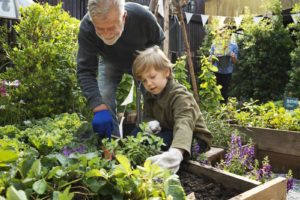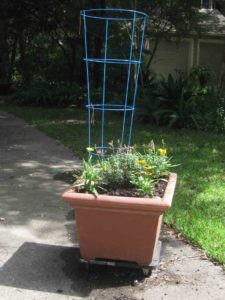With warmer temperatures finally (FINALLY!) here, it’s time to get serious about gardening. And similar to our earlier post on the magic of gardening with kids, this is a reminder of just how fun, educational, and eye-opening gardening with kids can be (for both parent and child alike).
For many of us, the prospect of putting in a first-time garden is daunting, even intimidating, and worries abound: Do I have enough room for a garden? How much time will it take to put in and maintain? How can I teach my child something I don’t even know?

The good news? Gardening is actually relatively painless, easy, and, again, a heck of a lot of fun. If you aren’t clear how to do it, admit that to your children and tackle the learning process together (humility + self-education = important life lesson).
Remember, gardening teaches kids a ton about the natural world, the interrelationship between soil and water and sun, the critical importance of pollinators in the food chain (more on that in a second), where their food comes from, and more.
“If you have a garden and a library, you have everything you need.” – Marcus Tullius Cicero
Perhaps best of all, gardening is something you can actually do with your kids – no watching from the sidelines, you’re up to your elbows (literally) in it with your child (and what kid doesn’t want to dig in the dirt a bit?).
Let’s briefly look at some garden types and how to get started.
Pollinator Gardens
Building a pollinator garden is probably the easiest way to practice gardening with kids. Whether you’re using a simple pot on the porch or patio or putting in a full garden, a pollinator garden is a fantastic way to teach your kids the critical relationship between bees, butterflies, birds, and other pollinators to our food supply. They also can make for an incredibly beautiful addition to your home’s landscape.

To get started with your own pollinator garden, determine which plants and flowers are native to your particular region of the country. You can use your ZIP to find the answer as well as a convenient planting guide.
Our friends at Kids Gardening asked us to remind everyone of the Million Pollinator Garden Challenge, a nationwide campaign aimed at creating gardens and habitats for pollinators under siege from rampant development and the use of pesticides, herbicides, etc.
As of this post, the campaign has registered 674,512 pollinator sites and counting. Why not add your garden to the list?
Once you know what to plant, the rest is just a matter of tilling and fertilizing a spot or creating a container for your pollinator garden. The image below is a small mobile container garden created by Kids Gardening. The advantage of a mobile container is that you can wheel it to different locations for improved sun management.

Container Gardens
Container gardens (also known as raised bed gardens) can be a fast and reasonably easy way to garden with a child. From pots to pre-fabricated kits to full-blown DIY-built containers, these gardens are a convenient way to grow vegetables, flowers, and other plants.
Here at Kidzu we just put the finishing wraps on our own container – yes, with one of our kids, who thoroughly enjoyed the building process (power tools and dirt, woo-hoo!).
For our 6 x 8 container garden, we followed a simple video instructional, using cedar boards, pine braces, plastic bags for interior lining, and lots and lots of dirt. For our finishing touches, we added a generous layer of cow manure and two inches of rich, organic container soil. We’ll follow up later with the harvest.
The key, for us, was to empower our teenaged son to do as much of the work as he wanted, including sawing the pine braces (cheap 2x4s), pre-drilling and then power-screwing the braces to the cedar walls, and adding the soil.
Planting comes next, with plans to plant tomatoes, cherry tomatoes, cucumbers, green beans, scallions, carrots, summer squash, and sugar snap peas. At the same time we will surround the container with pollinator plants to attract butterflies, bees, and other garden friends.
In-Ground Gardens
The most traditional of gardens is, of course, an actual in-ground garden where you till the soil, fertilize, plant, water, nurture and wait. These gardens require a bit of room but, if you’ve got it, why not use it?
And if you don’t have the room? Why not try a community garden, where you can work a spot of land amongst your neighbors. Use this handy resource to locate community gardens near you.
Putting in your own? We found this resource to be particularly useful, in part because it speaks to the many issues that impact a successful garden (neighboring vegetation, root systems, sun exposure, water, size, soil types, and more).
The bottom line: put in a garden with your child. It will be one of the most rewarding activities you can share and one that you will enjoy for weeks and months to come.
